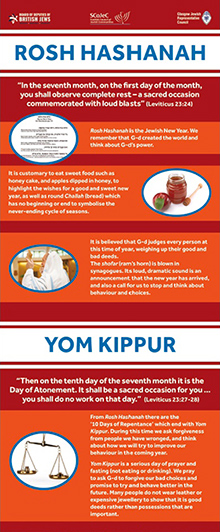|
|
Judaism and the Jewish Community
Jewish Festivals:
Rosh Hashanah and Yom Kippur |
| |
|
| |
|
| |
| |
|
Additional Information |
● |
The shofar is made from a ram’s horn, and therefore reminds us of the ram that Abraham offered as a sacrifice in place of his son Isaac – a story which showed his loyalty to G-d. |
● |
The shofar sounds like the trumpet–blasts that traditionally announce the coronation of a king because on Rosh Hashanah we acknowledge the Sovereignty of G-d. Similarly, it is said that the coming of the Messiah will be announced by the sound of a shofar, so this is a symbol of looking forward to a messianic era when everyone will live in peace. |
● |
The sound of the shofar can be piercing, stirring our conscience to confront any things we wish we hadn’t done. According to tradition, the giving of the Ten Commandments at Mount Sinai was accompanied by the sounding of a shofar. It is therefore a reminder to be a people of Torah, and to keep G-d’s commandments. |
● |
Many people give extra charity before Rosh HaShanah and during the Ten Days of Repentance to remind themselves to think of others, and to occupy themselves with good deeds at this special time of year. |
● |
There are many local and family traditions to eat special foods on Rosh Hashanah. The commonest is dipping apples in honey to symbolise a sweet new year, and to eat round challah (rather than the usual plaited bread) because eternity is often represented as a circle, which never ends. It also symbolises the world, which is round, as Rosh Hashanah is traditionally the anniversary of Creation and is referred to as the birthday of the world. |
● |
Rosh Hashanah and Yom Kippur are together known as the Days of Awe, and the ten days from one to the other are known as the Ten Days of Repentance. Special prayers are added to synagogue services to give people an opportunity to reflect on the past year and resolve to do better in the year ahead. |
● |
Yom Kippur starts in the evening with a service called Kol Nidrei (“All the promises”) that recognises that we might not have done our duty or kept our promises, and asks for forgiveness. There are four services during the day, often without a break, and the final service, Ne’ilah (“Closing”) is usually sung to very moving melodies to symbolise that this is our last chance to make up for last year’s mistakes. |
|
| |

|
|
| |
Suggested discussion questions and activities |
● |
Do you think it’s a good idea to have a day set aside each year for thinking about your behaviour and apologising to people and to G-d? |
● |
Do you think fasting and prayer are good ways to show that you are sorry for doing something wrong? What else could people do to show they want to change and improve themselves? |
● |
If you hurt someone else, in some religions, a priest can grant you forgiveness, whereas Judaism believes that only the person you hurt can forgive you, so you have to apologise directly to them and to make amends. Which do you think is more likely to stop you doing the same thing again? |
|
| |
Additional resources |
|
| |
| |
| |
|
|
|